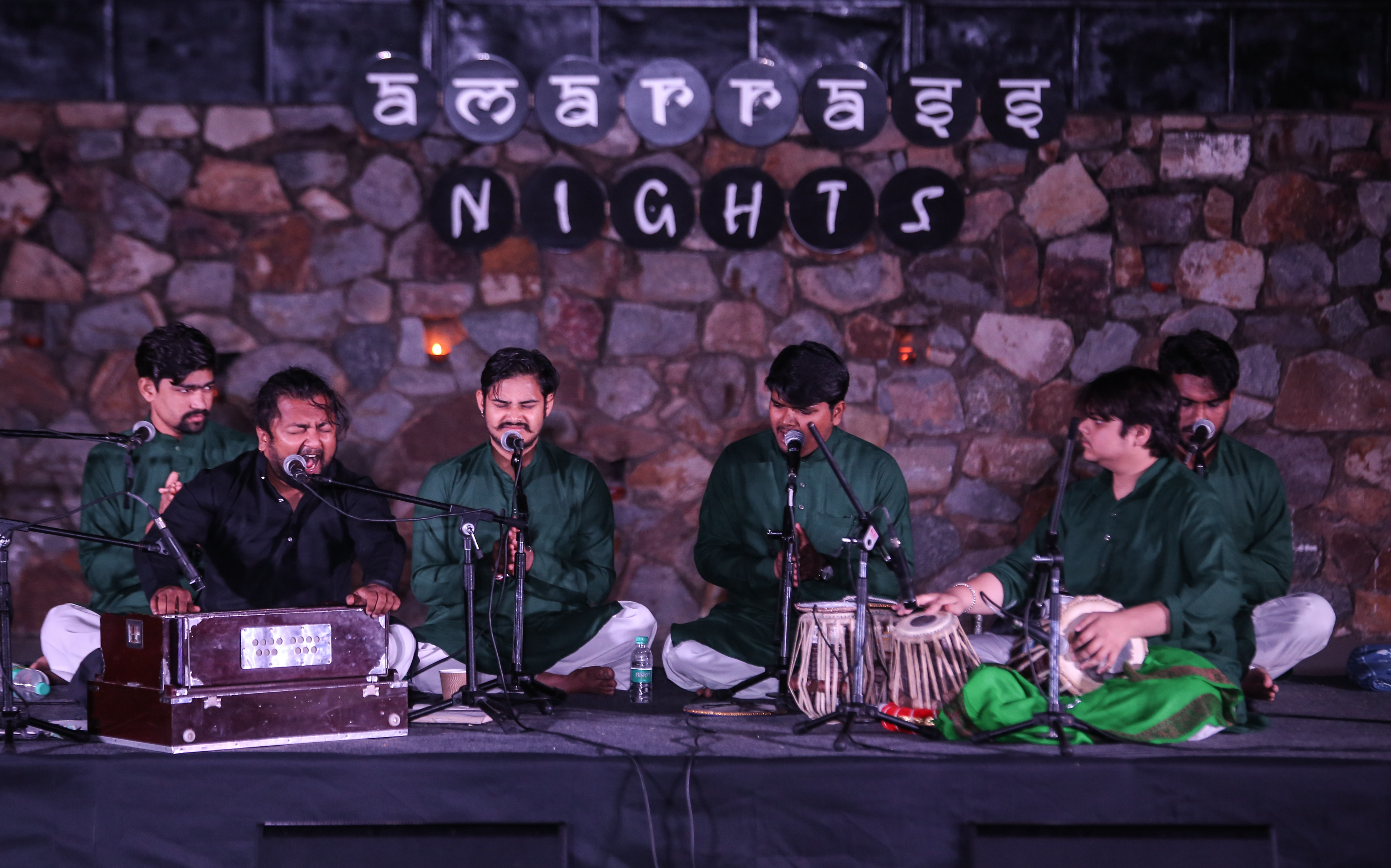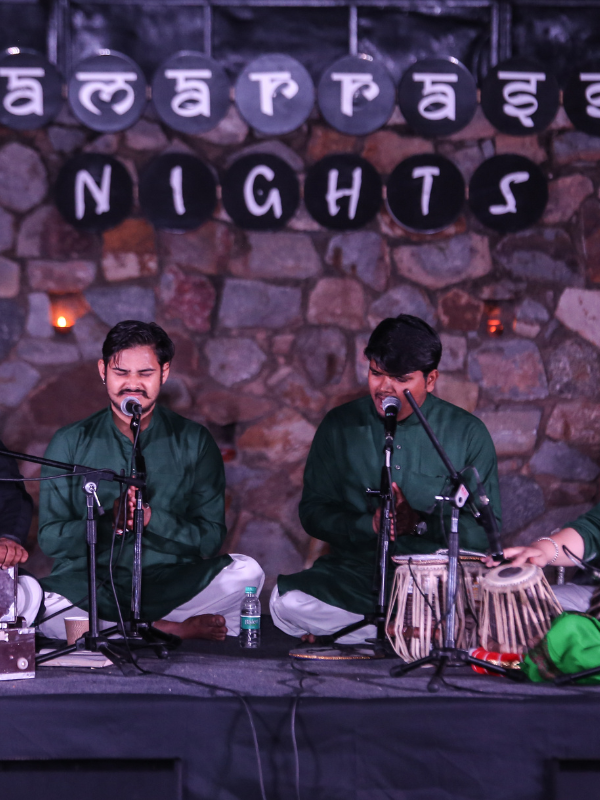

Interviewed by Sharad Kohli
Music with an Eternal Essence
Founded by Ashutosh ‘Ashu’ Sharma
and Ankur Malhotra in 2009, Amarrass Records is an outlier in the music
industry. This record label has given unknown (or not so well-known)
individuals and collectives a platform to showcase their talent, on
long-players and in gigs, and in genres as diverse as folk, electronic, trance
and psychedelic.
Besides, there’s a fidelity to
the old way of doing things. Every record is brought out in vinyl, and is
recorded, mixed, mastered and cover-designed by Amarrass. “The way records were
made initially, one record at a time, with somebody putting sound on one side
of a blank record,” Ashutosh told us. In 2023, the label began hosting music
tours, a concept that blends music with the culture and food of the region from
where the artists hail. One attendee called the experience “a journey for all
five senses.”
Amarrass has seven artists on its
roster—Lakha Khan, Barmer Boys, Rehmat-e-Nusrat, Ravana & Jumme Khan, Sakar
Khan, Ghewar & Firoze, and Bagga Khan—and has worked with a host of others.
Now 15 years old, and having released 23 quality albums in that time, this
record label is eagerly looking forward to presenting listeners, both in India
and abroad, with more musical discoveries. Says Ashutosh, “The general reaction
to the new music or the new artists we’re introducing has been great, so it
just gives you more energy to continue working in this direction.”
Interview by Sharad Kohli
‘COZ MUSIC NOURISHES MY SOUL
I had been into
music as a listener, and I always wanted to do something with it. I was in touch with
some artists in Pakistan, for instance, the Mekaal Hasan Band and I was trying
to get their music out. It so happened that they had signed up with a record
label in India, and it now boiled down to buying their rights—in order to do
so, an email had to be sent to that record label from a travel agency. Since I
was running a travel agency already, I felt I could really expedite the process
and sent that email. Another catalyst which led me to promote certain artists
was the constant frustration with the music scene in India, one only
got to hear the same acts throughout the year, the same bands and musicians,
whether at festivals or shows. Even in classical music, when we look
at tabla players, we don’t know nos. 5 to 10 in the country, and the average
person wouldn’t know the same for a sitar or sarod player. So, that was the
frustration, that we don’t get to hear different music, fresh music, and other
musicians—it used to drive me nuts and that led me to the current path.
To work with artists who are not so well-known and
unknown- Through the travel company we landed up in the folk scene in Rajasthan,
with the Manganiyars. When we launched the label, we released the album we’d
heard, The Manganiyar Seduction, directed by Royston Abel. We were handling
their travel and all that, and when we heard them, we realised this music is
amazing—it doesn’t require lights or boxes, it’s good enough to stand on its
own. So, we launched the label with the release of that album, and a show at
Purana Qila in 2010.
The Purana Qila show- a big wake-up call. I found it very
strange that the 4,000 who had come to watch the show—which made it to Time
magazine—and heard the musicians, went back knowing only the name of the
director and this new record label. They didn’t know the name of a single
artist! The reason I found it strange was because in art forms, everything is
based around the individual. That’s when we realised that we needed to work on
these musicians, to create their identities. So, we started field recordings
and releasing their work. Initially, these were compilations, in which we put
their names and photos. Once that was done, we then worked on the second set of
albums where we created bands like Barmer Boys. Hearing one guy in the village,
we thought, ‘He needs a name and a band’. Then we got artists from different
villages and imagined what that sound will be like. We told them, ‘We’re
forming a band but it’s your band,’ and explained it to them. Within two years
Barmer Boys had gone on to play at Coke Studio and by the third year they got a
slot in the Roskilde Music Festival in Denmark, between Outkast and The Rolling
Stones.
Need to archive the songbooks- We realised that over
the generations, the songbooks were dying, so we started archiving those. We
were working with the late Sakar Khan ji, the master of the kamaycha who
was awarded the Padma Shri, someone who had played with Yehudi Menuhin, George
Harrison and Bade Ghulam Ali Khan, but was unknown. We released his first
proper album when he was 75, and that album got Top of the World/5 Star ratings
from Songlines, UK. He also told us that there is only one kamaycha
maker left in the country, who was making sofas in Pune because he had
no orders. So, we launched a society for the performing arts, where we started
archiving the songbooks as well as creating an ecosystem for the instrument
makers and reviving that art as well.
The idea behind Amarrass Nights was
to work with folk and other artists. The artists
only had videos recorded in their village, and nobody would give them that
first show without seeing a video of that performance. So, I just decided to
create a platform for them and then make those videos—that’s how Amarrass
Nights started, in 2011 in Lodhi Gardens. That enabled the artist with a
portfolio, of their performances. Interestingly, here we have been presenting
all the bands that are technically ‘not so safe’ in terms of box-office appeal.
Amarrass Nights is curated and planned in a way that you won’t know the names
of the band or know of these bands!
The idea was never to work only with a specific genre
but because we started with folk, the initial focus was on the folk scene. We have worked
with bands doing psychedelic Arabic and we’ve done the revival of Charanjit
Singh, who is considered the father of Acid House. So, we are not genre
specific, it’s just that a lot of our work has been in the folk space, and we
always want to put in extra effort for that, because it’s one space that
requires that extra effort.
When you’re working with musicians, and when something
is created live while you’re recording or even while you’re practicing, it
gives you joy. As it does when bands that we have created from scratch make it to the
big stages, like Barmer Boys have done, or even Lakha Khan ji, who was awarded
a Padma Shri a few years ago. The fact that we recorded Sakar ji when we
could—our first set of analog, single-take field recordings—and when the artist
gets that level of recognition (five stars from Songlines), makes it all worth
it. And when the Smithsonian director says they may use our recordings for
reference, it tells you that you’re doing something right.
The most recent artists we signed are arguably one of
the best qawwals in the country, Rehmat-e-Nusrat. They came in as a Kumaoni folk
group, and their alter ego is this qawwali group. The lead singer, Sarvjeet
Tamta, heard Nusrat Saheb and lost the plot. He started learning. He wanted a
harmonium but his father couldn’t buy one so he left home and he self-trained
in vocals in qawwali, then he learnt Urdu and Farsi, went to Wadali Saheb to
learn a bit—in that sense, he’s all self-trained.